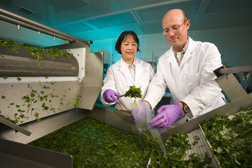|
Read the
magazine
story to find out more. |
|

Food technologist
Yaguang Luo and plant pathologist James McEvoy collect a sample of sanitized
fresh-cut cilantro from a produce washer. Click the image for more
information about it.
|
High-Tech Packaging Keeps Cut Produce Fresh
By Rosalie Marion
Bliss July 6, 2006
An Agricultural Research Service (ARS) scientist has identified specific
packaging wraps, called films, which provide several fruit and vegetable
varieties with a long shelf life. Food technologist
Yaguang
Luo, with the ARS Produce Quality and Safety Laboratory (PQSL),
Beltsville, Md., led the project. The technology she used is known as "modified
atmosphere packaging," or MAP.
Fresh-cut fruit and vegetable varieties are still alive, and each
respires at its own unique rate. Therefore, a film's permeability and the
amount of oxygen initially infused into a package are key.
Manufacturers have produced hundreds of different types of films, and
each type has its own oxygen transmission rate, which allows sliced produce to
continue breathing throughout storage and distribution. If a film's oxygen
transmission rate is too high for the variety it's wrapping, the product inside
will brown; if it's too low, the product will prematurely decay.
Luo's research findings led to developing a balance of oxygen and
carbon dioxide inside select packages that permits a particular fresh-cut
produce variety to respire slowly and stay fresh for the longest possible time.
For example, fresh-cut cilantro--a leafy culinary herb that's a
popular flavor component of tomato salsa--has a high respiration rate that
makes storage a challenge. Leaf yellowing, dehydration and loss of aroma can
set in quickly after cutting. The packaging film Luo has identified for
wrapping cilantro provides a 14-day shelf life. So the cilantro has plenty of
time to be plucked from the grocery shelf and chopped to enliven a fresh batch
of salsa.
Using similar advanced packaging technologies, Luo has been able to
prolong the shelf life of romaine lettuce, iceberg lettuce, carrots and salad
savoy, a nutritious new vegetable crop that is a close relative to kale and
cabbage.
Read
more about this research in the July 2006 issue of Agricultural Research
magazine.
ARS is the U.S. Department of
Agriculture's chief scientific research agency.